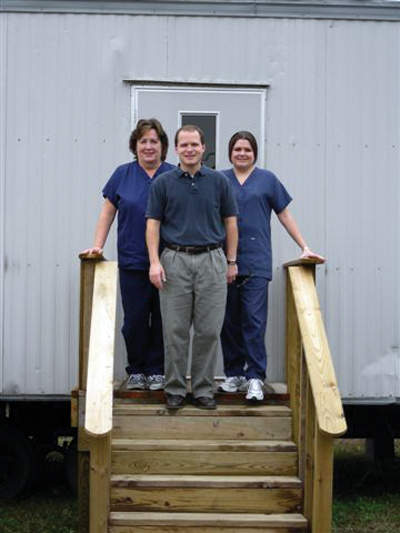After Hurricane Katrina demolished the Gulf Coast of Mississippi, the only thing left of optometrist James Benignos office in Pass Christian was the concrete slab. Everything elseequipment, computers, walls and roof had been ripped away.
Dr. Benigno established a temporary office in a modular unit about two miles from the beach. He has a permit to operate this office for up to 24 months. Currently, business is doing very well, he says.
 |
| With his faithful staff members behind him, Dr. James Benigno now works in a temporary office. |
Dr. Benigno plans to build a new freestanding office on higher ground. I feel strongly that we need to help Pass Christian rebuild and grow by opening a practice in town, he says. I hope to see the small town that I grew up in come back better.
About 200 miles away in Winnsboro, La., in the northeast part of the state, Albert C. Burns, O.D., is settling back into a routine. His New Orleans home was flooded, and his office is unusable. When the hurricane hit, Dr. Burns evacuated to the Superdome for a few harrowing days. He was separated from his wife for almost a week.
Dr. Burns occasionally thinks about that experience, but now he spends most of his time battling with his property insurance company and trying to figure out what to do with his home and office in New Orleans. Hes not sure yet whether the city plans to restore or raze his neighborhood. Meanwhile, Dr. Burns has taken up practice at a Wal-Mart and has moved out of a motel and into a house.
Down in New Orleans, optometrist Jarrett Johnson has been hard at workbut without an office. Before Hurricane Katrina hit, Dr. Johnson had an office in the Lower 9th Ward, where she practiced for 15 years. The office is still there, but it was flooded with 12 feet of water when Katrina hit. Then, Hurricane Rita flooded the office again, taking the roof with it this time.
Dr. Johnson had the foresight to pack up her medical records and computers, and she evacuated to Texas. But she wasnt there long when Vision Service Plan (VSP) called her to come back to New Orleans to provide eye care as part of the relief effort.
Since early October, Dr. Johnson has led a team of 13 other optometrists to deliver replacement eyewear and provide ocular care in temporary clinics. Two such clinics are aboard cruise ships. Others are in nursing homes, Army tents, schools and community health centers.
A lot of people who come in [to the clinics] were patients of the public hospitals [which are now closed] or are newly uninsured because they were laid off from their jobs as a result of Katrina, Dr. Johnson says. Typical cases include ocular foreign-body removal and conjunctivitis as well as glaucoma patients in the middle of post-op care or those who have lost their medication.
Many homeowners and handymen forget to wear eye protection. Were constantly digging out debris [from their eyes], Dr. Johnson says. Metal shavings, wood shavings, Sheetrock, plaster, you name it.
At home, Dr. Johnson has been living on the second floor of her house. The first floor was flooded and is now gutted. Her VSP assignment will be up soon, and shes not sure what her next move is.
Most important, she hopes to see her children back in local schools by the start of the next school year. Since Katrina, her children have been staying with friends in Texas because the schools in New Orleans are closed.
On the other side of the city, optometrist David Heitmeier recently re-opened his office. He says that business has picked up to about two-thirds of what it was before Katrina.
Many patients come in with infections from the Katrina crudsludge left behind after the water receded. Ive seen more corneal ulcers in the past month than what I used to see in half a year, Dr. Heitmeier says. Hes following six such patients right now.
Slowly, things are returning to normal. Dr. Heitmeiers office was just re-carpeted, and the moldy smell is almost gone. The baseboards are on backorder, but most of the equipment is now working.
| Optometric Community Pitches In Several organizations have responded to the call for help in the wake of Hurricanes Katrina and Rita. Vision Service Plan pledged $15 million in financial support and eye care services. More than 7,000 people have been seen through VSPs mobile eye clinics. Also, VSP distributed more than 65,000 vouchers for free eye exams and glasses to evacuees and has provided financial assistance to VSP-affiliated doctors affected by the storm. American Optometric Associations Disaster Relief Fund has raised $481,607 in donations and has distributed 103 grants (of $2,000 each) to optometrists who were affected by the catastrophe. To donate, go to www.aoa.org/webmtg/katrina.htm. Optometry Association of Louisianas Relief Fund has collected $13,230. Also, 15 optometrists from out of state have become associate members, says James Sandefur, O.D., the associations executive director. Donations are still welcome. Call 1-888-388-0675 or e-mail optla@bellsouth.net. Mississippi Optometric Associations Optometric Foundation has collected about $14,000 and is still accepting donations. Call (601) 853-4407 or e-mail msoptometr@aol.com. Vision Council of Americas Vision Alliance and Relief Fund has raised about $150,000 in monetary donations and about $300,000 in eyewear. To donate, call (703) 548-4560 or go to www.visionsite.org. University of Houston College of Optometry established triage centers and standalone primary eye-care centers at the Astrodome and the Convention Center, treating a total of 2,800 patients. In the weeks after the hurricanes, the University Eye Institute provided eye exams to more than 600 evacuees. Northeastern State University College of Optometry faculty and students examined and provided eyeglasses and contact lenses to more than 200 evacuees at a National Guard camp near the school. Pennsylvania College of Optometrys Eye Institute provided eye exams, through VSPs voucher program, and additional assistance to more than 50 Katrina evacuees. |

